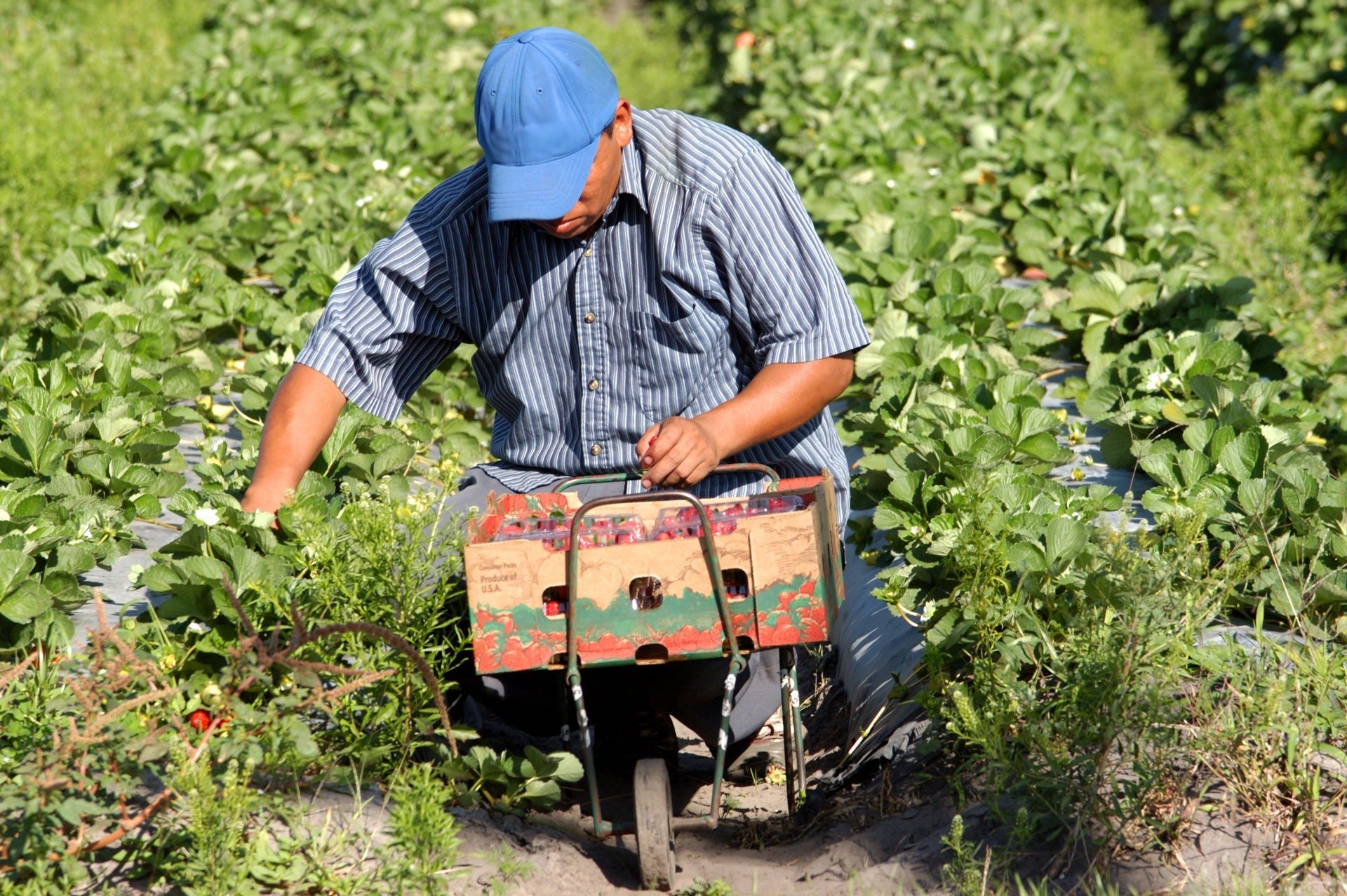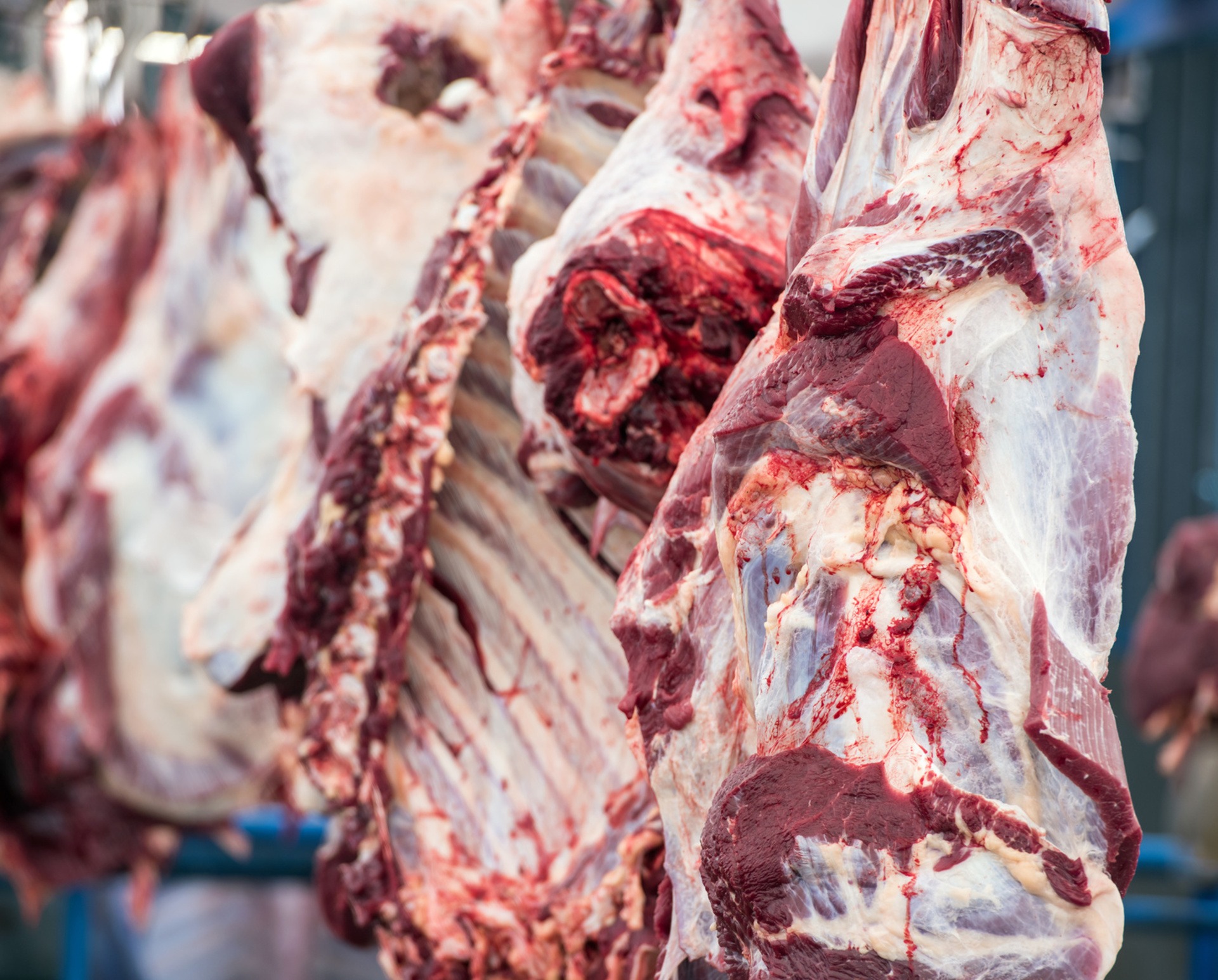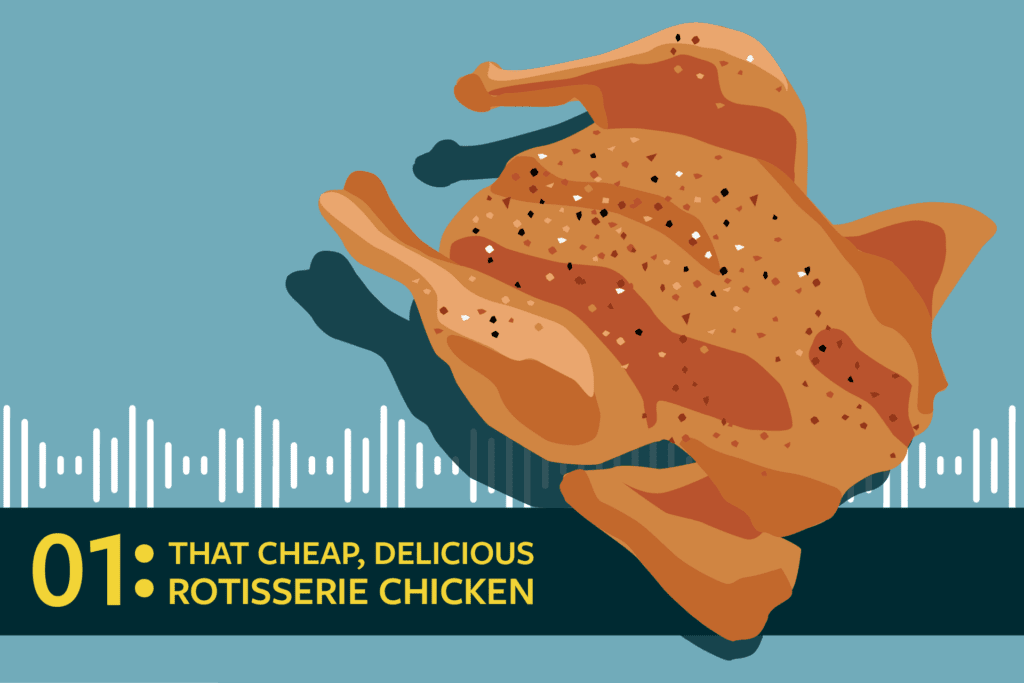The ‘unseen hands’ of the food system
This essay is excerpted from “Good Eats: 32 Writers on Eating Ethically,” a new anthology from NYU Press that explores the question of “eating well” from multiple angles. Elsewhere in the collection, you’ll find pieces from the editors — Jennifer Cognard-Black on fatphobia, Melissa A. Goldthwaite on food as medicine — as well as essays by writers like Taté Walker, Adrienne Su, Nikky Finney and Ross Gay covering issues from colonialism to carnivore culture.
As a young journalist not yet doing the immigration reporting I felt called to do, Jay Lynn Gomez’s art spoke to me. The Mexican artist, born to undocumented parents, became known for making visible the “invisible” migrant laborers in affluent areas of Los Angeles. Her early work consisted of painted life-sized cardboard figures photographed outside of extravagant homes—the unknown brown nannies, gardeners, and housekeepers behind the elaborate estates.
The workers’ faces were often blurred out, forming slight swirls of brown skin. Their clothing was dull—in grays, blues, and black—shading them out to the rest of the world. Sometimes they held mops or brooms or were posed next to trash cans. Sometimes they held other women’s newborns. Looking at these figures, I imagined the pain of leaving your children behind in Mexico or El Salvador, only to find yourself in the United States raising someone else’s peachy-pink babies, your life filled with lush landscapes in affluent neighborhoods that you know both intimately and not at all.
While I hate narratives that flatten immigrant communities to sound bites about how they do the jobs “Americans don’t want to do,” I am very familiar with the dynamic of unseen labor and the way that most Americans do not seem to notice that Latinx workers keep the country afloat.
I first became conscious of invisibilized labor because of my dad. He entered the United States without authorization in the 1970s and lived as an undocumented immigrant for nearly two decades before becoming a US citizen in 1991 through marriage to my mom. My dad is a brown man with an accent who speaks English as his second language, and when I was growing up, he mostly worked in hospitals, either prepping food in cafeterias or doing janitorial work. Sometimes he worked in school cafeterias. Sometimes he juggled all of these jobs at once, but even after he adjusted his status, he never veered far from the work we associate with “immigrant labor.” At seventy-one, he just retired from the hospital where he spent nineteen years working as a janitor.
My dad has long described scenarios to me in which white patients, doctors, and hospital staff didn’t even notice his presence. It’s almost as if it was easier to pretend that their trash was magically carted off by a ghost than to have interacted with or acknowledged him. The idea that people found my father so easy to ignore is unbelievable to me. In our family, my dad has the presence of a life force. My father is kinetic, always doing something with his hands—cleaning, grilling, flipping through his favorite albums, petting his beloved dog Daisy, rolling a tortilla in his hands, or making a cup of coffee. He talks authoritatively on any subject; he is stubborn, incapable of letting injustice slide, and known for flying into fits of rage. Portrayals of immigrants as humble, shy people were laughable to me because I grew up with a man who preened, with a man who knew his worth, with a man who always had to have the last word. Try as they might, no one has ever been able to make my dad feel small, even when his line of work is so often used as a punch line.
I come from a family of people who perform crucial, unseen labor. These are workers like my dad’s cousin, who migrated with him to the US and spent his life as a baker in a bread factory, and my uncle, who lived with my family in Southeast Los Angeles when he first migrated to the US, and who worked at a dairy factory. Of course, there were also many family friends—all Mexican immigrants—who I grew up believing were actual relatives. I didn’t realize until I was an adult that these were mostly friends my dad had connections with back in Mexico or people he made friends with upon arriving in the US. These were people like my “uncle” Salvador, who picked grapes in California’s Central Valley. They worked to put food on our tables, and I saw the consequences of this work firsthand. I saw it in the disposable ways their employers treated them, and I saw it in their meager paychecks and broken bodies. My “cousin” Soraida still works the land in Central Valley, doing the labor her father Salvador did. She’s described to me the way she prepares for work, waking in the wee hours of the morning and pulling on jeans and a long-sleeve shirt to protect against sunburn and pesticides. I always imagine her hands in a blur as she plucks and snips grapevines.
Everyone in my family dreamt of being something other than what they became. I do not know why I was able to envision being a journalist and achieve it—outside of incredible luck. It is not lost on me that the intellectual work I do covering migrant workers is highly visible in a way their unseen labor is not. But the family I grew up in fundamentally shaped the way I report on labor and food systems, topics I know to be inextricably linked to immigration. Just as I grapple with the tensions of covering migrant workers as an outsider, I am deeply aware of the moral issues that arise from our food choices and how it is often migrant workers—in restaurant kitchens, fields, and meat and poultry processing plants—who have to navigate the consequences. What I don’t know is what to do about it.
As a journalist, my ultimate goal is to help readers understand that the hired hands in agriculture are real, breath-and-bone people like “Luz,” a pseudonym used by a Mountaire Farms poultry plant worker in North Carolina. I was introduced to Luz in the spring of 2020 by a Latinx advocacy organization in Siler City, North Carolina, that works closely with migrant workers in the region. At the time, I was embarking on what I did not know would be a year-and-a-half investigation into the poultry industry’s two-tier worker system in the state, propped up by hard-to-trace staffing agencies—agencies that offer migrant workers exploitative labor agreements to work in plants for major corporations like Mountaire Farms.
For weeks on end, Luz and I got into long text exchanges in the middle of the day when she was on break from her job deboning chicken at the Mountaire Farms poultry processing plant in Lumber Bridge. The stories she shared, always in quick bursts, were shocking.
It was the height of the pandemic, and Luz’s plant was granted a line waiver by the Department of Agriculture’s Food Safety and Inspection Service to increase the speed of chicken processed each minute, going from 140 birds to 175. The workers couldn’t keep up, she told me. Chicken was routinely backed up on the line, and it was falling onto the floor. Animal slaughtering and processing facilities have long been some of the most dangerous workplaces in the country, and these already deadly conditions were exacerbated as workers were forced to work at breakneck speeds during a pandemic. More people were injuring themselves, Luz said in her text messages, and sometimes these injuries should have been reported to the North Carolina Occupational Safety and Health Division. But workers were afraid to tell their bosses and risk losing desperately needed jobs. This was the same reason some workers came to work sick with COVID.
Poultry companies do not want to claim undocumented workers as their own—though these workers are the backbone of their multibillion-dollar industry. Meat and poultry processing plants were some of the largest COVID “hot spots” during the early days of the pandemic, and the workers in these facilities risked their lives so that Americans had food on their tables. Forty percent of these workers are foreign-born. Overwhelmingly, they are Mexican immigrants. It should come as no surprise, then, that in rural areas where poultry plants are common sights, Latinx communities were disproportionately impacted by COVID. In North Carolina, Siler City was once the epicenter of the pandemic. At one point during the summer of 2020, nearly 50 percent of all COVID-19 cases were among Latinx North Carolinians, even though the Latinx population of North Carolina is approximately 10 percent of the state.
Women like Luz risked it all to go to work. Like many of her coworkers, she was a Mexican immigrant, and she was terrified of getting infected and terrified of losing her job at the plant. I didn’t get to know Luz much as a person. This was by design. She was firm about the parameters of her life and the information she felt comfortable sharing with me. As a migrant worker, Luz was worried about retaliation from her employer—or worse. (In August 2019, Immigration and Customs Enforcement carried out the largest workplace raid in US history across seven poultry processing plants in Mississippi.) But Luz was invested in the reporting I was doing, and for a time, we worked on it collaboratively. She shared information about the plant, and I provided her with information to share with her coworkers—background on the owners of the staffing agencies that employed them, how much these agencies made off each hour of their labor, and news about outbreaks in the plants, which workers found especially helpful. Mountaire Farms workers alleged that the company did not provide information about testing in Spanish and didn’t inform them of outbreaks at the plant, or if they worked alongside people who tested positive for COVID.
More than anything, Luz wanted the world to understand how unjustly migrant workers are treated, especially women who work in poultry plants. At the plant in Lumber Bridge, she estimated that about half of the workforce during her shift were immigrant women. Some were pregnant, she said, and some were elderly and had preexisting health conditions. They were caretakers, mothers, and the primary breadwinners in their families. They feared COVID—not just because they feared death, but because of the ripple effect it would have in their families both in North Carolina and in Mexico or El Salvador or Guatemala or Honduras or wherever they sent remittances to support their children, parents, and extended families.
I wanted to know so much more about Luz than she was willing to share, but I did not push. I spent lots of time trying to imagine what she looked like, what her life was like in North Carolina, and what her motivations were for speaking out. When I knew she was at work, I tried to picture her in her uniform and imagine the sharp, fast movements her hands made while deboning chicken. I wondered if she felt any sense of pride or any sadness when she saw Mountaire Farms chicken at the grocery store.
One evening, before Luz and I were scheduled to do another phone interview, she texted me to say she was feverish and didn’t feel well. She wanted to reschedule our interview so that she could get tested for COVID. I never heard from her again. I tried to contact her for months. I still don’t know what happened to her.
The reporting Luz helped me with was published more than a year later, and as is the nature of reporting complicated stories that must endure intense scrutiny in the form of fact-checking, much of the information Luz shared with me didn’t make it into the story. Because she didn’t share her real name, because we mostly communicated over text, because she disappeared, and because Mountaire Farms refused to respond to workers’ allegations, the information she gave me could not be verified in the tidy way that standards of journalism require.
But what Luz shared echoed what other workers experienced. I believe everything she told me. Not a week goes by that I don’t think about her. Even though I’ve seen how Americans erase migrants’ labor from our food systems, I was still not prepared for the way my investigation changed me. I now understand the human cost of cheap chicken. I cannot peruse the poultry aisle of a grocery store without thinking about the migrant workers behind each package of perfectly butchered chicken quarters or deboned chicken thighs.
Their unseen hands haunt me.
Reprinted with permission from “Good Eats: 32 Writers on Eating Ethically,” edited by Jennifer Cognard-Black and Melissa A. Goldthwaite. NYU Press, 2024.
Get the latest food news, from FoodPrint.
By subscribing to communications from FoodPrint, you are agreeing to receive emails from us. We promise not to email you too often or sell your information.
Top photo by alipko/Adobe Stock.
More Reading
Restoring Native foodways requires returning land. What happens when it's contaminated?
June 10, 2025
Big Banana’s bitter labor truths
May 13, 2025
The racist roots of Black land loss
February 25, 2025
Why worker welfare is critical to truly “sustainable” wine production
January 10, 2025
How we came to rely on emergency food
September 30, 2024
Food and farmworkers need protection from heat and other dangers
August 28, 2024
How can ecofeminism help us envision the future of food?
July 18, 2024
A new agritourism network connects and promotes farmers of color
June 11, 2024
After season 2 of ‘High on the Hog,’ there is more to be told
March 19, 2024



